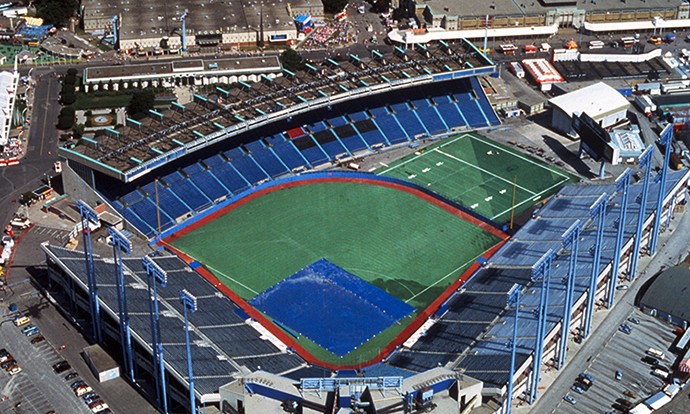Since the start of last season, the Toronto Blue Jays have been unable to play at Rogers Centre, their home ballpark. The Jays spent 2020 at their Triple-A stadium, Sahlen Field in Buffalo, New York, and are splitting this season between Sahlen Field and TD Ballpark, the club’s spring training home in Dunedin, Florida.
After spending the past year-plus at minor league fields, Toronto is likely yearning to get back to their true home. However, if the same situation occurred before 1989, Sahlen Field and TD Ballpark would probably be upgrades from their home field.
Exhibition Stadium: the Beginnings
Before the SkyDome (Rogers Centre), there was Exhibition Stadium. The first home of the Blue Jays, Exhibition has an interesting history. The left-field bleachers were originally constructed in 1948, after a previous set on the site burned down the year prior. The rest of the stadium was built around the bleachers, slowly expanding through the years.
Exhibition Stadium was initially expanded for the Toronto Argonauts, a CFL team that moved to the stadium in 1959. The first game played by the Argonauts here was an exhibition between the home team and the NFL’s Chicago Bears. It was the first game ever played between NFL and CFL teams.
In the early 1970s, Toronto began looking to attract a baseball team. Renovating Exhibition Stadium into a multi-purpose monstrosity, they very nearly poached the Giants out of San Francisco. However, the move was eventually stopped by San Francisco mayor George Moscone and several court decisions. When Major League Baseball announced its plan to expand, Toronto was chosen as a new location, with the Blue Jays set to debut at Exhibition Stadium in 1977.
As you can see in the featured image, this resulted in an extremely awkward-looking stadium.
Mistake on the Lake II
“Mistake on the Lake” was, of course, the nickname for Cleveland Municipal Stadium, which hosted the Indians and the Browns. However, Exhibition was sometimes known as a “Mistake on the Lake” as well, due to its location near Lake Ontario.
The weird shape of the stadium was actually amongst the least of the Jays’ worries. The stadium, which had no roof and no covering above any seats except those in left field, was often absurdly cold. Nearby Lake Ontario was also known to invite extreme wind and snow to constantly invade the field.
The construction of the stadium also forced awkward sightlines on many fans. Since the sets of bleachers were intended for football, they faced directly towards the field. But during baseball games, these seats didn’t face the field, instead looking straight at the other set of bleachers.
Here’s an outline of the stadium, drawn by Andrew Clem:

Play Ball!
The Jays played their first game at Exhibition Stadium on April 7, 1977, hosting the Chicago White Sox. While fans were ready to watch their new MLB team, the Toronto weather wasn’t. The field was covered in a layer of snow, which continued to fall throughout the game. To clear it, the Blue Jays actually had to borrow a Zamboni from the Toronto Maple Leafs.
The Jays played at Exhibition Stadium until the 1989 season, and there was no shortage of weird weather events in their time at the field. In 1984, a game between Toronto and the Texas Rangers was postponed due to high winds. Jim Clancy, the Jays’ starter that day, was literally blown off balance by the winds numerous times, and the game was called after only six pitches.
Another effect of Lake Ontario was seagulls (As someone who went to school on the shore of Lake Ontario, I can personally attest to the amount of seagulls). Seagulls would flock near, and on, the field throughout the season. This led to a notorious incident in baseball history.
Dave Winfield and the Seagull
On August 4th, 1983, the New York Yankees were in town, taking on their division rivals at Exhibition Stadium. Dave Winfield, in the midst of his 10th consecutive All-Star season, was on the field. While warming up, Winfield threw a ball towards the ballboy, a ball that instead struck a seagull.
It’s debated whether Winfield intentionally hit the seagull or not, but nonetheless, it was dead. In the minds of Jays fans, however, Winfield was guilty. He was booed, and some fans even threw things on the field.
That wasn’t the end of it, however. After the game ended, Winfield was arrested (seriously!). The stadium police officers had determined that Winfield killed the seagull intentionally, and charged him with “unnecessary suffering of an animal”.
Naturally, the Yankees were outraged. Manager Billy Martin, who was never difficult to rile up, said, “They wouldn’t say that if they’ve seen the throws he’s been making all year. It’s the first time he’s hit the cutoff man.”
Blue Jays GM Pat Gillick paid a $500 bond to release Winfield, and the charges were dropped the next day. Just like Jim Clancy, the whole situation eventually blew over.
(Details via SABR)
Exhibition Stadium: the Final Days
The Blue Jays left Exhibition in 1989, after 12 full seasons (and part of a 13th) at the stadium. Their final game at the park took place on May 28 of that year. Toronto’s brand-new ballpark, the SkyDome, opened midseason, and the Jays played their first game there eight days later, on June 5.
Exhibition Stadium remained open for several years following the departure of the Jays, mainly hosting large concerts. It was demolished in 1999, and BMO Field was opened on the site in 2007.
Since that 1989 season, the Blue Jays have played at the SkyDome (known as Rogers Centre since 2005). As mentioned earlier, the team has not actually played at the park since 2019, instead playing games at both Sahlen Field and TD Ballpark.
Exhibition Stadium: Specs
Opened: 1977
Closed: 1999
Capacity: 43,737
Dimensions:
- Left Field: 330 feet
- Left-Center: 375 feet
- Center Field: 400 feet
- Right-Center: 375 feet
- Right Field: 330 feet




